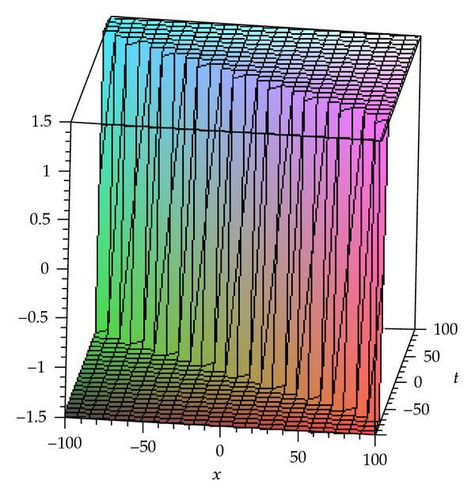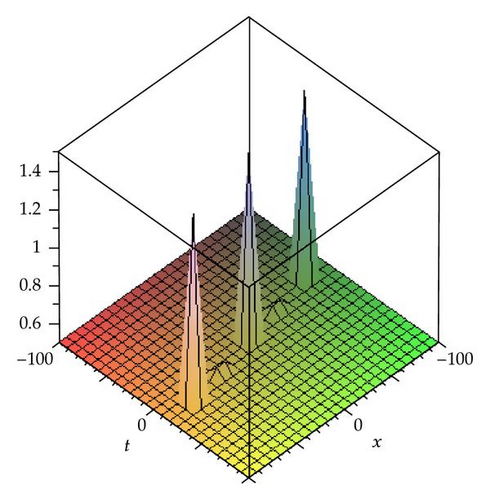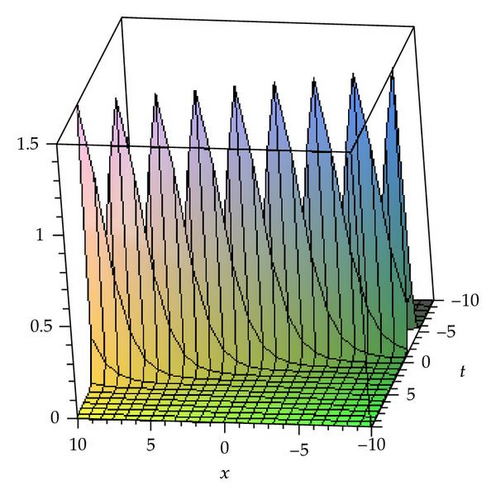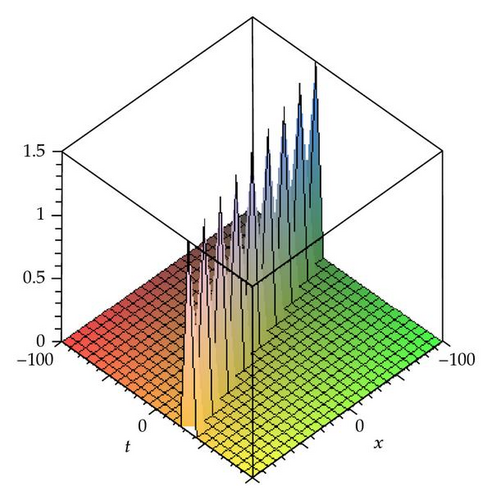New Traveling Wave Solutions of the Higher Dimensional Nonlinear Partial Differential Equation by the Exp-Function Method
Abstract
We construct new analytical solutions of the (3 + 1)-dimensional modified KdV-Zakharov-Kuznetsev equation by the Exp-function method. Plentiful exact traveling wave solutions with arbitrary parameters are effectively obtained by the method. The obtained results show that the Exp-function method is effective and straightforward mathematical tool for searching analytical solutions with arbitrary parameters of higher-dimensional nonlinear partial differential equation.
1. Introduction
Nonlinear partial differential equations (NLPDEs) play a prominent role in different branches of the applied sciences. In recent time, many researchers investigated exact traveling wave solutions of NLPDEs which play a crucial role to reveal the insight of complex physical phenomena. In the past several decades, a variety of effective and powerful methods, such as variational iteration method [1–3], tanh-coth method [4], homotopy perturbation method [5–7], Fan subequation method [8], projective Riccati equation method [9], differential transform method [10], direct algebraic method [11], first integral method [12], Hirota’s bilinear method [13], modified extended direct algebraic method [14], extended tanh method [15], Backlund transformation [16], bifurcation method [17], Cole-Hopf transformation method [18], sech-tanh method [19], (G′/G)-expansion method [20–22], modified (G′/G)-expansion method [23], multiwave method [24], extended (G′/G)-expansion method [25, 26], and others [27–33] were used to seek exact traveling wave solutions of the nonlinear evolution equations (NLEEs).
Recently, He and Wu [34] have presented a novel method called the Exp-function method for searching traveling wave solutions of the nonlinear evolution equations arising in mathematical physics. The Exp-function method is widely used to many kinds of NLPDEs, such as good Boussinesq equations [35], nonlinear differential equations [36], higher-order boundary value problems [37], nonlinear problems [38], Calogero-Degasperis-Fokas equation [39], nonlinear reaction-diffusion equations [40], 2D Bratu type equation [41], nonlinear lattice differential equations [42], generalized-Zakharov equations [43], (3 + 1)-dimensional Jimbo-Miwa equation [44], modified Zakharov-Kuznetsov equation [45], Brusselator reaction diffusion model [46], nonlinear heat equation [47], and the other important NLPDEs [48–51].
In this article, we apply the Exp-function method [34] to obtain the analytical solutions of the nonlinear partial differential equation, namely, (3 + 1)-dimensional modified KdV-Zakharov-Kuznetsev equation.
2. Description of the Exp-Function Method
Step 1. Consider a complex variable as
Step 2. We assume that the traveling wave solution of (2.3) can be expressed in the form [34]
Step 3. In order to determine the values of c and p, we balance the highest order linear term with the highest order nonlinear term, and, determining the values of d and q, we balance the lowest order linear term with the lowest order nonlinear term in (2.3). Thus, we obtain the values of c, d, p, and q.
Step 4. Substituting the values of c, d, p, and q into (2.5), and then substituted (2.5) into (2.3) and simplifying, we obtain
3. Application of the Method
In this section, we apply the method to construct the traveling wave solutions of the (3 + 1)-dimensional modified KdV-Zakharov-Kuznetsev equation. The obtained solutions will be displayed in Figures 1, 2, 3, 4, 5, and 6 by using the software Maple 13.






Zayed [52] solved (3.1) using the (G′/G)-expansion method. Later, in article [53], he solved same equation by the generalized (G′/G)-expansion method.
Here, we will solve this equation by the Exp-function method.
Case 1. We set p = c = 1 and q = d = 1.
For this case, the trial solution (2.5) reduces to
Set 1. We obtain that
Set 2. We obtain that
Set 3. We obtain that
Set 4. We obtain that
Now, substituting (3.11) into (3.8), we obtain traveling wave solution
If b−1 = 1 from (3.16), we obtain
If α is negative, that is, α = −β, β > 0, b0 = 2 and a0 = 0, then from (3.18), we obtain
If b0 = 1, α = 6, and a1 = 1/2, (3.20) becomes
If a0 = 3 and α = 8, (3.22) becomes
Case 2. We set p = c = 2 and q = d = 1.
For this case, the trial solution (2.5) reduces to
Set 1. We obtain that
Set 2. We obtain that
Set 3. We obtain that
Set 4. We obtain that
Using (3.26) into (3.25) and simplifying, we obtain that
Substituting (3.27) into (3.25) and simplifying, we obtain that
Substituting (3.28) into (3.25) and simplifying, we obtain that
Using (3.29) into (3.25) and simplifying, we obtain that
Case 3. We set p = c = 2 and q = d = 2.
For this case, the trial solution (2.5) reduces to
If we put a−2 = 0, a−1 = 0, b2 = 1, b−2 = 0, and b−1 = 0 into (3.39), we obtain the solution form as (3.8). This implies that the Case 3 is equivalent to the Case 1.
Also, if we consider p = c = 3 and q = d = 3, it can be shown that this Case is also equivalent to the Cases 1 and 2.
Therefore, we think that no need to find the solutions again.
It is noted that the solution (3.17) and (3.31) are identical, solution (3.19) and (3.33) are identical, solution (3.21) and (3.35) are identical, and solution (3.23) and (3.37) are identical.
Beyond Table 1, Zayed [52] obtained another solution (3.39). But, we obtain two more new solutions (3.21) and (3.23).
Graphical Representations of the Solutions The above solutions are shown with the aid of Maple 13 in the graphs.
4. Conclusions
Using the Exp-function method, with the aid of symbolic computation software Maple 13, new exact traveling wave solutions of the (3 + 1)-dimensional modified KdV-Zakharov-Kuznetsev equation are constructed. It is important that some of the obtained solutions are identical to the solutions available in the literature and some are new. These solutions can be used to describe the insight of the complex physical phenomena.
Acknowledgment
This paper is supported by USM short-term Grant no. 304/PMATHS/6310072, and the authors would like to express their thanks to the School of Mathematical Sciences, USM for providing related research facilities. The authors are also grateful to the referee(s) for their valuable comments and suggestions.




